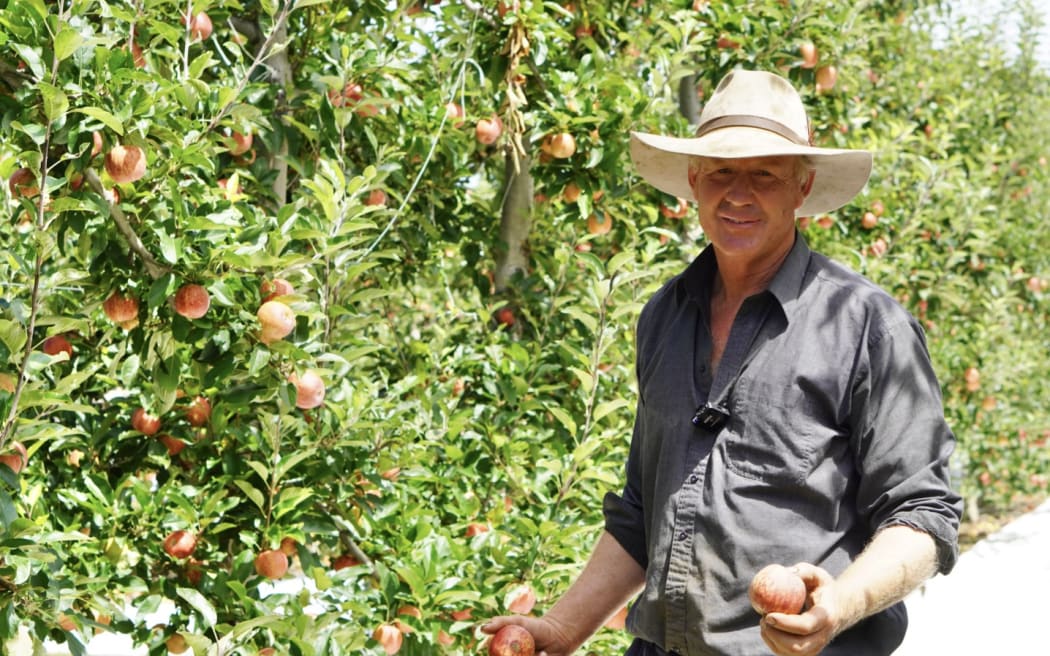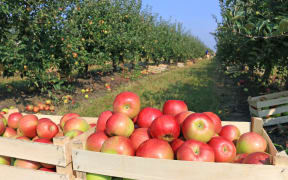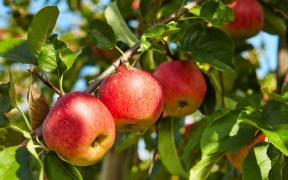
Jonty Moffett with some of his remaining apple trees Photo: RNZ / Kate Green
A Hawke's Bay grower fears there could be a repeat of the destruction caused by Cyclone Gabrielle if flood protection work isn't prioritised.
Most of Jonty Moffett's orchards sit between the Ngaruroro and Tutaekuri Rivers - and they both flooded on 14 February last year.
His orchards, pack-house, family home and that of his parents and brother were all flooded.
Sixty hectares of apple trees and 85 percent of his melon crop were wiped out - so he planted vegetable crops to get some much need cash flow into the business.
"This paddock here was all apple trees as far of the hills, it was covered it silt it was so deep you couldn't walk on it and digging it out wasn't really an option.
"I'm pretty happy with that decision now, it's kept people in a job anyway."
Most of Moffett's land is now in crops of corn, peas and maize.
"It's nowhere near as profitable as apples, but we had to do something, my father set up this business about 50 years ago and we're starting from the bottom."

Jonty Moffett in front of his corn crop. Photo: RNZ / Kate Green
He said they'd received a huge amount of help from their bank and Woolworths - who they supply to - as well as volunteers who came to help after the flooding.
But the business faces huge costs of about $200,000 a hectare to replant the apple orchards.
Moffett said it was hard to make decisions about investing when the basics of flood protection still have not been addressed.
"We're more vulnerable now than we were pre-cyclone, what needs to happen with the flood protection is somehow we need to slow down the water up in the hills and then speed it up once it gets down here on the flats.
"A lot of riparian margins and vegetation which were alongside the rivers is gone and that was holding the water up in the back country for longer - now when it rains, it comes down faster and the water is slowing up and spreading out on the plains.
"The regional council has fixed the stopbanks but they're not dredging the river - it's definitely something you consider when you're going to the bank to borrow millions of dollars to replant the apple orchards," he said.
Hawke's Bay Regional Council asset management group manager Chris Dolley said a huge amount of effort has gone into reinstating the Heretaunga Plains and Tukituki Flood schemes over the last year.
"We've repaired all of the breaches which was 5.6 kilometres where stopbanks were significantly damaged and another 25 kilometres of stopbanks that had minor damage, that's been a big focus, but we still have a lot of work to do."
He respected that people had a heightened awareness of flooding, but said the level of protection that was in place now was the same as it was before the cyclone.
"So our stopbank network within the schemes provide a high level of protection, which means in any one year there's only a one percent chance that anything untoward could occur.
"So that protection is back, but I understand there is heightened sensitivity about the impacts of these devastating events."
Dolley said the Hawke's Bay Regional Council already took a significant amount of gravel out of the rivers but is surveying them again to see if more needs to be done.
He said everyone is doing their best to recover from Cyclone Gabrielle a year on, but it will take the best part of a decade to recover.



